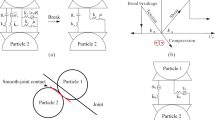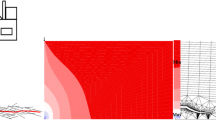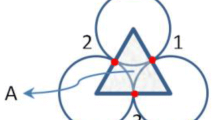Abstract
With improvements to the bonded-particle model, a custom indicator of crack intensity is introduced to grade rock fractures accurately. Brittle fracturing of rock mass is studied using the bonded-particle model; here, “brittle” refers to the process where more energy is released towards making particles collide and disperse, and hence results in the quick emergence of “chain cracks”. Certain principles concerning how to construct brittle rock are then proposed. Furthermore, a modeling approach for brittle rocks based on the adaptive continuum/discontinuum (AC/DC) method is proposed to aid the construction of large-scale models of tunnel excavations. To connect with actual tunneling conditions, fundamental mechanical properties, the mechanism for brittle fracturing, the joint distribution, and the initial stress field are considered in the modeling approach. Results from micro-seismic monitoring of a tunnel excavation confirmed the suitability of this modeling approach to simulate crack behavior, and results show that simulated cracking exhibit similar trends (evolution, location, and intensity) with micro-seismic cracking.





















Similar content being viewed by others
Abbreviations
- AC/DC:
-
Adaptive continuum/discontinuum method
- BPM:
-
Bonded-particle model
- Pbrick:
-
An assembly of particles within a periodic space
- F :
-
Resultant force
- M :
-
Resultant moment
- E c :
-
Particle modulus
- E p :
-
Parallel bond modulus
- k n :
-
Normal stiffness
- k s :
-
Shear stiffness
- \( k_n^c /k_s^c \) :
-
Stiffness ratio of contact
- \( k_n^p /k_s^p \) :
-
Stiffness ratio of parallel bond
- R max :
-
Maximum particle size
- R min :
-
Minimum particle size
- ρ :
-
Particle density
- σ c :
-
Tensile strength of bond
- τ c :
-
Shear strength of bond
- ∆σ c :
-
Standard deviation of tensile strength
- ∆τ c :
-
Standard deviation of shear strength
- μ :
-
Friction coefficient
- ψ :
-
Dilation angle
References
Bieniawski ZT (1967a) Mechanism of brittle fracture of rock, PartΙ-theory of the fracture process. Int J Rock Mech Min Sci 4:395–406
Bieniawski ZT (1967b) Mechanism of brittle fracture of rock, PartII-experimental studies. Int J Rock Mech Min Sci 4:407–411
Chaboche JL (1988) Continuum damage mechanics. J Appl Mech 55:59–72
Cho N, Martin CD, Sego DC (2007) A clumped particle model for rock. Int J Rock Mech Min Sci 44:997–1010
Hazzard JF, Young RP (2000) Simulating acoustic emissions in bonded-particle models of rock. Int J Rock Mech Min Sci 37:867–872
Hazzard JF, Young RP (2002) Moment tensors and micromechanical models. Tectonophysics 356:181–197
Holt RM, Kjolaas J, Larsen I, Li L, Pillitteri AG, Sonstebo EF (2005) Comparison between controlled laboratory experiments and discrete particle simulations of the mechanical behavior of rock. Int J Rock Mech Min Sci 42:985–995
Itasca Consulting Group (ICG) (2008) PFC3D user’s guide version 4. ICG, Minneapolis
Krajcinovic D (1984) Continuum damage mechanics. Appl Mech Rev 37:1–6
Krajcinovic D (1989) Damage mechanics. Mech Mater 8:117–197
Ma CC, Li TB, Cheng GQ, Cheng ZQ (2015) Study of micro particle model for hard brittle rock and the effect of unloading rock burst. Chin J Rock Mech Eng 34:1–11
Mas Ivars D (2010) Bonded particle model for jointed rock mass. Dissertation, Royal Institute of Technology (KTH), Stockholm, Sweden
Mas Ivars D, Potyondy DO, Pierce M, Cundall PA (2008) The smooth-joint contact model. 8th world congress on computational mechanics and 5th European congress on computational methods in applied sciences and engineering. Venice, Italy
Mas Ivars D, Pierce M, Darcel C, Reyes-Montes J, Potyondy DO, Young RP, Cundall PA (2011) The synthetic rock mass approach for jointed rock mass modelling. Int J Rock Mech Min Sci 48:219–244
Pierce M, Mas Ivars D, Cundall PA, Potyondy DO (2007) A synthetic rock mass model for jointed rock. In: Proceedings of the 1st Canada–US rock mechanics symposium, Taylor and Francis, Vancouver
Potyondy DO, Cundall PA (2004) A bonded particle model for rock. Int J Rock Mech Min Sci 41:1329–1364
Tarokh A, Fakhimi A (2014) Discrete element simulation of the effect of particle size on the size of fracture process zone in quasi-brittle materials. Comput Geotech 62:51–60
Tawadrous AS, DeGagne D, Pierce M, Mas Ivars D (2009) Prediction of uniaxial compression PFC model micro-properties using neural networks. Int J Num Anal Meth Geomech 33:15–25
Ting JM, Khwaja M, Meachum LR, Rowell JD (1993) An ellipse-based discrete element model for granular materials. Int J Numer Anal Meth Geomech 17:603–623
Wang EZ, Shrive NG (1995) Brittle fracture in compression: mechanisms, models and criteria. Eng Fract Mech 52:1107–1126
Wawersik WR, Fairhurst C (1970) A study of brittle rock fracture in laboratory compression experiments. Int J Rock Mech Min Sci 7:561–575
Yoon J, Stephansson O, Dresen G (2004) Application of design of experiments to process improvement of PFC model calibration in uniaxial compression simulation. In: Proceedings of the 4th Asian rock mechanics symposium (ARMS-4), Singapore
Zhang XP, Wong LNY (2012) Cracking processes in rock-like material containing a single flaw under uniaxial compression. Rock Mech Rock Eng 45:711–737
Acknowledgments
This research was supported by National Natural Science Foundation of China (Grant Nos. 41230635 and 41172279), and the open fund (Grant No. SKLGP2015K004) from the State Key Laboratory of Geo-hazard Prevention and Geo-environment Protection, China.
Author information
Authors and Affiliations
Corresponding author
Ethics declarations
Conflict of interest
The authors declare that we have no conflict of interest.
Rights and permissions
About this article
Cite this article
Ma, CC., Li, TB., Xing, HL. et al. Brittle Rock Modeling Approach and its Validation Using Excavation-Induced Micro-Seismicity. Rock Mech Rock Eng 49, 3175–3188 (2016). https://doi.org/10.1007/s00603-016-0941-0
Received:
Accepted:
Published:
Issue Date:
DOI: https://doi.org/10.1007/s00603-016-0941-0




